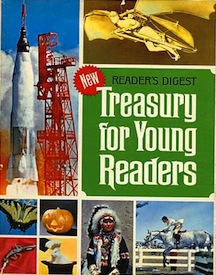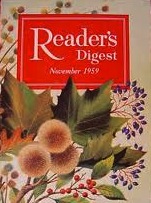What makes a story so unforgettable that it stays with you for most of a lifetime?
I asked myself that question during a recent quest to find a story I never forgot from childhood. I wrote about the story four years ago while talking about the early influence of Reader’s Digest in my story passion.
The story is “Ordeal in the Desert,” by Evan Wylie, a true story of a family that got stuck in the Utah desert in 1959 and struggled for survival.
I first read it, not in Reader’s Digest itself, but in a Reader’s Digest Treasury  for Young Readers [pictured] that belonged to my sister.
for Young Readers [pictured] that belonged to my sister.
I looked the story up in 2008 when I wrote that blog post about Reader’s Digest, but was not successful. I wasn’t the only one for whom the story was unforgettable. A few years after my post, a message board on the site LibraryThing, carried this query:
If I remember correctly, a story about a family (Prescotts) being stranded in Death Valley was in a Reader’s Digest Family activity and story book I read around 1979. It might have been published around 1975. Now that I think about it, the story said the starving family ate several crayons and a tube of glue.
I was motivated to mount another search for the story by a Toastmasters assignment in the Interpretive Reading manual to read a story. I couldn’t think of a story I wanted to read more. I wanted to see if my audience would find the story as unforgettable as I did.
 This time my search yielded pay dirt. I found the story on Google Books. As I piece things together, it looks like the story [pictured] was first published in a Sunday newspaper supplement magazine, Family Weekly, which I believe is no longer published, on Sept. 27, 1959. In that publication, the story was titled, “8 Against Death in the Desert.”
This time my search yielded pay dirt. I found the story on Google Books. As I piece things together, it looks like the story [pictured] was first published in a Sunday newspaper supplement magazine, Family Weekly, which I believe is no longer published, on Sept. 27, 1959. In that publication, the story was titled, “8 Against Death in the Desert.”
In the magazine, the story, not having yet landed in the hands of the condensation geniuses at Reader’s Digest, was much longer than I remembered. I was about to become intimately familiar with just how long. Items on Google Books, as far as I can tell, can neither be printed out, nor copied and pasted. So, if I was to read the story for Toastmasters, I would have to type it. All 3,161 words of it.
My heart sank as I did because I knew 3,161 words read aloud would go way beyond the time limit of the Toastmasters assignment.
What I needed was … the Reader’s Digest version. So I started searching  again and learned that the condensed version was published in the November 1959 RD, and I could order a copy from a reseller for just 5 bucks. It arrived last week, and with just a bit more trimming, I can read the story in the allotted time at Toastmasters.
again and learned that the condensed version was published in the November 1959 RD, and I could order a copy from a reseller for just 5 bucks. It arrived last week, and with just a bit more trimming, I can read the story in the allotted time at Toastmasters.
Today I took my research a step further. I wanted to identify the exact Reader’s Digest Treasury for Young Readers in which I had first seen the story. I not only found it — I recognized the cover instantly — but ordered a copy. Another $5 bargain!
I am excited to receive it because I believe it contains another unforgettable story I mentioned in that 2008 post — about a tailor who sewed a love note into the seam of the wedding dress of a woman who was marrying another. In my memory, the story was titled “The Wedding Dress,” a title a bit too generic to help me find it through the miraculous Internet. It’s possible I read that story in Reader’s Digest itself rather than the treasury. I’ll find out when I get the book. When it arrives, my journey with “Ordeal in the Desert” will have come fill circle.
I wish I could learn more about “Ordeal in the Desert” author Evan Wylie. He seems to have written a number of true-life-adventure magazine stories and a couple of screenplays. And I wish I could analyze why I’ve remembered his story for close to five decades. It was well-written and dramatic. I could probably identify with the plight of the children in the story. As a story fan, however, I’d love to explore more about what elements comprise a story that sticks.
In a research paper, Beth Black concludes:
What are key features of stories that “stick”?
- Stories that “stick” have a telic* structure; they build to a satisfying ending that has a point.
- Stories that “stick” convey facts with emotion.
- Stories that “stick” include neither too few nor too many sensory details.
*Telic: directed or moving towards some goal; purposeful
Yes. I believe “Ordeal in the Desert” fits those characteristics.
